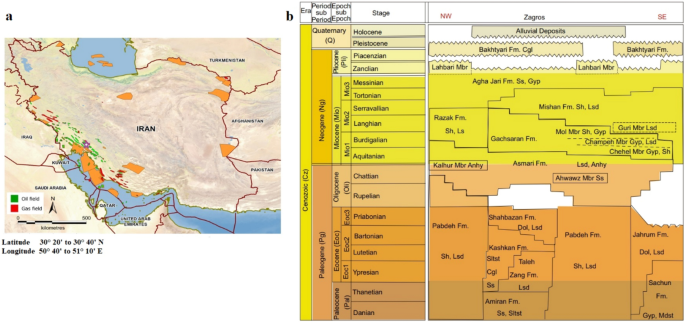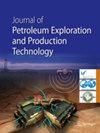Coupled hydro-mechanical simulation in the carbonate reservoir of a giant oil field in southwest Iran
IF 3.2
4区 工程技术
Q3 ENERGY & FUELS
Journal of Petroleum Exploration and Production Technology
Pub Date : 2023-09-11
DOI:10.1007/s13202-023-01695-2
引用次数: 0
Abstract
Abstract The Asmari reservoir in southwest Iran has been producing oil continuously for over 50 years. However, due to an essential pressure decline, the reservoir is now a potential candidate for injection projects. The geomechanical analysis is essential for a successful injection operation to enhance reservoir production and address possible challenges. An accurate estimation of the injection pressure is necessary to maintain optimal conditions during the injection process and reduce possible risks. In this work, a coupled reservoir-geomechanical model, as well as rock mechanical tests, is performed to evaluate not only pressure variation and the associated in situ stress changes but also their potential influences on fault reactivation, reservoir–caprock stability, and surface displacement. For geomechanical evaluation, empirical correlations are derived between static and dynamic rock properties based on core data and existing petrophysical logs for the studied reservoir–caprock system. Based on the hydro-mechanical results, the maximum displacement is limited to the vicinity of the injection wells, where the highest pressure changes occur. The geomechanical analysis of the reservoir–caprock system shows that this system is stable until the injection pressure reaches 4.3× the initial reservoir pressure. Also, the injection pressure is not high enough to compromise the integrity of faults, indicating that the loading on the fault planes is too low to reactivate the pre-existing faults. The approach followed in this study can be applied to future field development strategies and feasibility considerations for CO 2 sequestration and underground gas storage projects.

伊朗西南部某大油田碳酸盐岩储层流体-力学耦合模拟
伊朗西南部的Asmari油藏已经连续生产了50多年。然而,由于基本压力下降,该储层现在是注入项目的潜在候选者。地质力学分析对于成功的注入作业至关重要,以提高油藏产量并解决可能出现的挑战。准确估计注射压力对于在注射过程中保持最佳状态和降低可能的风险是必要的。在这项工作中,进行了油藏-地质力学耦合模型和岩石力学试验,不仅评估了压力变化和相关的地应力变化,还评估了它们对断层再激活、油藏-盖层稳定性和地表位移的潜在影响。为了进行地质力学评价,根据岩心数据和现有储盖系统的岩石物理测井资料,推导了静态和动态岩石性质之间的经验相关性。根据水力力学结果,最大位移限制在注水井附近,压力变化最大。储盖系统的地质力学分析表明,在注入压力达到初始储层压力的4.3倍之前,储盖系统是稳定的。此外,注入压力不足以破坏断层的完整性,表明断层面上的载荷太低,无法重新激活先前存在的断层。本研究所采用的方法可以应用于未来的油田开发策略和CO 2封存和地下储气库项目的可行性考虑。
本文章由计算机程序翻译,如有差异,请以英文原文为准。
求助全文
约1分钟内获得全文
求助全文
来源期刊
CiteScore
5.90
自引率
4.50%
发文量
151
审稿时长
13 weeks
期刊介绍:
The Journal of Petroleum Exploration and Production Technology is an international open access journal that publishes original and review articles as well as book reviews on leading edge studies in the field of petroleum engineering, petroleum geology and exploration geophysics and the implementation of related technologies to the development and management of oil and gas reservoirs from their discovery through their entire production cycle.
Focusing on:
Reservoir characterization and modeling
Unconventional oil and gas reservoirs
Geophysics: Acquisition and near surface
Geophysics Modeling and Imaging
Geophysics: Interpretation
Geophysics: Processing
Production Engineering
Formation Evaluation
Reservoir Management
Petroleum Geology
Enhanced Recovery
Geomechanics
Drilling
Completions
The Journal of Petroleum Exploration and Production Technology is committed to upholding the integrity of the scientific record. As a member of the Committee on Publication Ethics (COPE) the journal will follow the COPE guidelines on how to deal with potential acts of misconduct. Authors should refrain from misrepresenting research results which could damage the trust in the journal and ultimately the entire scientific endeavor. Maintaining integrity of the research and its presentation can be achieved by following the rules of good scientific practice as detailed here: https://www.springer.com/us/editorial-policies

 求助内容:
求助内容: 应助结果提醒方式:
应助结果提醒方式:


